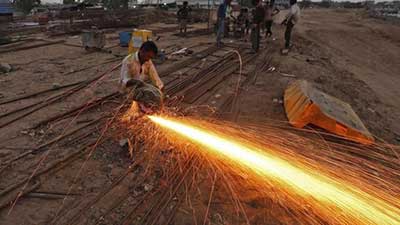Date: 15/12/2022
Relevance: GS-1: Effects of liberalization on the economy, changes in industrial policy and their effects on industrial growth.
Key Phrases: Manufacturing Sector, Manufacturing Activity, Employment, Bigger Cities, Smaller Towns, Rural Areas, Regional Development, constraints, Growth, Work Bank, Informal Sectors, Value Addition.
Context:
- The most noticeable trend in the manufacturing sector in India has been a shift of manufacturing activity and employment from bigger cities to smaller towns and rural areas.
- The dispersal of manufacturing activities is a welcome sign, given the size of the Indian economy and the need for balanced regional development,
- It could be advantageous and help in transforming the rural economy, or it could have a set of constraints, which could hamper higher growth.
Key Highlights:
- The World Bank in a report - Is India’s Manufacturing Sector
Moving Away from Cities? investigated the urbanization of the Indian
manufacturing sector by combining enterprise data from formal and informal
sectors.
- It found that manufacturing plants in the formal sector are moving away from urban areas and into rural locations, while the informal sector is moving from rural to urban locations.
- Recent data from the Annual Survey of Industries for 2019-20,
show that the rural segment is a significant contributor to the
manufacturing sector’s output.
- While 42% of factories are in rural areas, 62% of fixed capital is in the rural side.
- In terms of output and value addition, rural factories contributed to exactly half of the total sector.
- In terms of employment, it accounted for 44% but had only a 41% share in the total wages of the sector.
What caused the shift?
- The World Bank’s report suggested that higher urban-rural cost ratios caused this shift.
- The Annual Survey of Industries for 2019-20 considers that this is the result of a steady stream of investments in rural locations over the last two decades.
- There could be three explanations for this shift of manufacturing
away from urban locations-
- First is the Factory Floor Space Supply Constraints - When locations get more urbanised and congested, the greater are the constraints. However, continuing replacement of labour by machinery as a result of the continuous capital investments in new production technologies is the main driving force.
- Production Cost Differentials -Many firms experience substantially higher operating costs in cities than in rural areas, which affects firm’s profitability and competitiveness.
- Possibility Of Capital Restructuring - An approach advocated by Marxist geographers. According to this view, there is a tendency for growing capital accumulation and centralisation by large multi-plant corporations. Big firms deliberately shift production from cities to take advantage of the availability of less skilled, less unionised and less costly rural labour.
Effects of the shift in manufacturing activities:
- The shift from urban to rural areas has helped maintain the importance of manufacturing as a source of livelihood diversification in rural India.
- In the aftermath of trade liberalisation, import competition among Indian manufacturers intensified and to cut costs they moved some operations from cities to smaller towns, where labour costs are cheaper.
- This trend helped to make up for the loss of employment in some traditional rural industries.
- The growth of rural manufacturing, by generating new jobs, thus provides an economic base for the transition out of agriculture.
Do you know: Rural India played the economy’s ‘saviour’ in 2020-21
- The year 2020-21 saw the Indian economy register its worst-ever contraction since Independence and also the first since 1979-80.
- The National Statistical Office has, in its Provisional Estimates pegged the growth in real gross value added at basic prices) for 2020-21 at minus 6.2%.
- But what’s unusual this time is that the farm sector (agriculture, forestry & fishing) has grown by 3.6%.
- There have been four instances of negative GDP growth earlier: 1979-80, 1972-73, 1965-66 and 1957-58.
- All four were drought years, with agricultural de-growth surpassing that of overall GDP in each of them.
- The year 2020-21 has been different. There has been record economic contraction, yet no drought; the farm sector actually grew by 3.
Challenges Ahead:
- The shift towards rural manufacturing faces two major challenges:
- First, though firms reap the benefits of lower costs via
lower rents, the cost of capital seems to be higher for firms
operating on the rural side.
- This is evident from the shares in rent and interest paid. The rural segment accounted for only 35% of the total rent paid, while it had 60% of the total interest payments. The benefits reaped from one source seem to be offset by the increased costs on the other front.
- Second, there exists an issue of “skills shortage” in
rural areas as manufacturing now needs higher skilled workers to compete
in the highly technological global ‘new economy’.
- Manufacturers who depend only on low-wage workers simply cannot sustain their competitive edge for longer periods as this cost advantage vanishes over time. Manufacturers who need higher skilled labour find that rural areas cannot supply it in adequate quantities
- First, though firms reap the benefits of lower costs via
lower rents, the cost of capital seems to be higher for firms
operating on the rural side.
Conclusion:
- The above challenges suggest the need for solutions to the problems of rural manufacturing, of which the most important is the provision of more education and skilling for rural workers.
- A more educated and skilled rural workforce will establish rural areas’ comparative advantage of low wages, higher reliability and productivity.
- This will also help in the process of the movement out of agriculture to higher-earning livelihoods in rural areas,
Source: The Hindu
Mains Question:
Q. This ‘urban-rural manufacturing shift’ has often been interpreted as a mixed bag, as it has its share of advantages that could transform the rural economy, as well as a set of constraints, which could hamper higher growth. Critically Analyze.






















